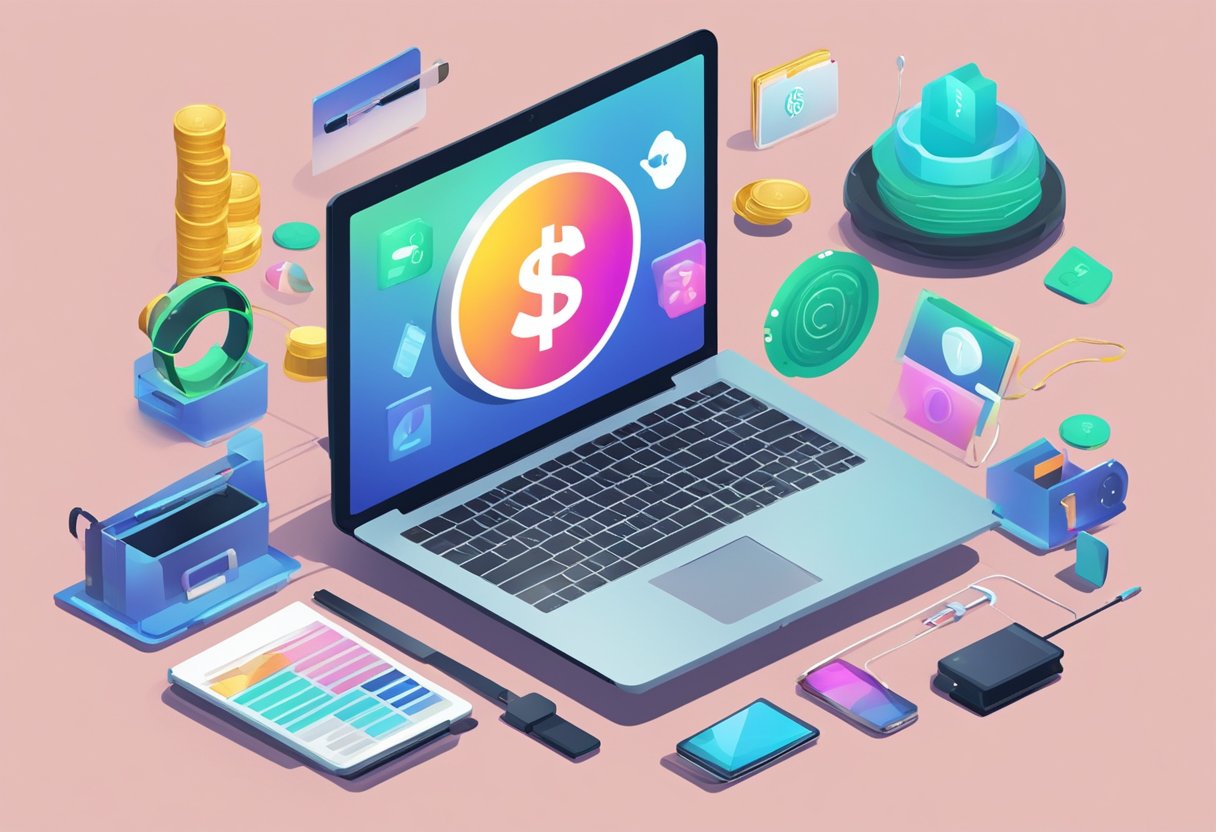How to Monetize a Tech Blog: Proven Strategies for Success
Monetizing a tech blog can turn a passion for technology into a source of income. By investing time in quality content and smart strategies, anyone can generate revenue from their blog. From product reviews to affiliate marketing, there are various effective methods to make money while engaging an audience that shares a common interest in technology.

Building a strong blog that attracts traffic is essential when monetizing. This involves using the right blogging platform and focusing on niche topics that resonate with readers. Once a solid audience is established, there are numerous ways to introduce income streams, such as sponsored posts or selling digital products.
Staying informed on trends in technology and blogging can enhance monetization efforts. Understanding what works best for the tech industry allows bloggers to adapt and grow their revenue over time.
Key Takeaways
- Quality content and audience engagement are critical for monetization.
- Utilizing diverse monetization methods can maximize income opportunities.
- Staying updated with industry trends aids in scaling revenue effectively.
Understanding Blog Monetization

Monetizing a tech blog involves various strategies that can generate income. It’s essential to define what monetization means and why having a solid strategy is crucial for success. Knowing the potential for a tech blog can also help guide the monetization plan.
Defining Blog Monetization
Blog monetization refers to the process of making money from a blog. This can involve several methods, including:
- Advertising: Displaying ads on the site.
- Affiliate Marketing: Earning commissions by promoting products.
- Selling Products or Services: Offering items related to the blog’s niche.
- Gated Content: Providing content that requires payment to access.
Each method has its pros and cons. Choosing the right approach depends on the blog’s content, audience, and goals.
Importance of a Monetization Strategy
Having a monetization strategy is vital. It serves as a roadmap to guide how the blog will generate revenue. A clear strategy helps to:
- Focus Efforts: Direct attention toward specific income avenues.
- Measure Success: Track the effectiveness of chosen methods.
- Adapt Quickly: Make changes as needed based on performance data.
Without a solid plan, blogs may struggle to earn consistent income. A well-structured strategy also allows for growth as the blog develops and attracts more readers.
Monetization Potential for Tech Blogs
Tech blogs often have high monetization potential due to their targeted audience. This niche attracts readers interested in the latest technology trends, gadgets, and software. Some ways to leverage this potential include:
- Sponsored Posts: Partnering with tech companies to create content that promotes their products.
- Freelancing: Writing articles for other tech sites, using the blog as a portfolio.
- Display Ads: Using networks to show ads relevant to tech enthusiasts.
Readers often seek trusted sources for tech information. By providing valuable content, the blog can build authority and, in turn, attract more monetization opportunities.
Setting Up Your Tech Blog
Setting up a tech blog involves several important steps. These include selecting a suitable blogging platform, finding a niche that can generate income, and optimizing content for search engines. Each of these factors is crucial for building a successful blog.
Choosing the Right Blogging Platform
Selecting the right blogging platform is the first step in starting a tech blog. Many bloggers prefer WordPress due to its user-friendly interface and flexibility. It offers numerous themes and plugins that enhance functionality.
Other platforms like Blogger and Medium also have their advantages but may lack the customization options of WordPress. Using a self-hosted WordPress setup allows for better control over the blog. This approach enables users to add features that enhance user experience and monetization opportunities.
Identifying a Profitable Tech Niche
Finding a profitable niche is essential for attracting the right audience. It is important to pick a specific area within the tech industry, such as gadgets, software, or app reviews. This focus helps establish authority and connects with a targeted audience.
Conducting keyword research can assist in identifying popular topics and gaps in the market. Tools like Google Keyword Planner can reveal search volumes and trends. A niche with both passion and profit potential ensures sustainable content creation.
Optimizing for SEO
Optimizing for SEO increases visibility and reaches a wider audience. First, bloggers should research relevant keywords and incorporate them into titles and content. This process helps search engines understand the topic of each post.
Moreover, ensuring that the blog is mobile-friendly and loads quickly is vital. Simple adjustments, like optimizing image sizes and improving site speed, can significantly enhance user experience and search rankings. Adding meta descriptions and alt text for images also contributes to better SEO.
Creating High-Quality Content

High-quality content is essential for attracting and maintaining a tech blog’s audience. It involves understanding what readers want and keeping up with the latest trends. This section will focus on how to engage the audience effectively.
Catering to Audience Interest
A tech blog must cater to the interests of its audience. This starts with identifying topics that resonate with readers. Engaging content includes product reviews, how-to guides, and discussions about the latest tech trends.
Using tools like Google Trends can help discover what people are searching for. Regularly checking popular articles and comments can provide insight into audience preferences. Additionally, personal experiences and expertise can enhance authenticity, making content more relatable.
Incorporating Trend Analysis
Keeping up with trends is crucial in the fast-paced tech industry. Writers should analyze current happenings and predict what may become relevant.
For instance, writing about new software releases or upcoming gadgets can draw in readers. Using data from sources such as Google Trends can help bloggers identify rising topics. Trend analysis not only boosts engagement but also positions the blog as a reliable source of information.
Expanding Content Types
To keep the audience engaged, a tech blog should use a variety of content types. This includes not only articles but also videos, infographics, and podcasts. Diverse formats can cater to different learning styles and preferences.
For instance, video tutorials can complement written guides, providing a more comprehensive understanding. Infographics can summarize complex information clearly, appealing to visual learners. By incorporating multiple types of content, bloggers can enhance user experience and attract a wider audience.
Traffic Acquisition and Audience Building

Building traffic and an audience is vital for monetizing a tech blog. A focused strategy helps attract the right readers and keeps them engaged. Successful traffic acquisition involves organic growth, effective use of email lists, and active participation in technology communities.
Growing Organic Traffic
Organic traffic is essential for reaching more potential readers without spending on ads. It involves optimizing blog content for search engines. This includes using relevant keywords, creating quality content, and incorporating meta descriptions effectively.
Using tools like Google Analytics can help track which topics attract the most traffic. Regularly updating content and writing guest posts on other tech blogs boosts visibility. Building backlinks is also important; having other reputable sites link to the blog increases its authority.
Utilizing Email Lists and Newsletters
Email lists and newsletters are powerful tools for maintaining reader engagement. They allow direct communication with the audience, keeping them informed about new posts and updates. To build an email list, tech bloggers can offer free resources like eBooks or courses.
Creating compelling newsletters with valuable content encourages subscribers to stay connected. Keeping the design simple and the information clear helps maintain reader interest. A consistent schedule for sending newsletters builds routine, making readers expect content regularly.
Engaging with Technology Communities
Joining technology communities can be an effective way to grow blog traffic. Platforms like Reddit, Stack Overflow, and Facebook groups are ideal for connecting with the target audience. Actively participating by answering questions and discussing topics builds the blogger’s personal brand.
Sharing blog links where appropriate can drive traffic back to the site. Engaging with fellow community members can lead to collaborations, increasing visibility. Staying involved in trends and discussions keeps the blog relevant and attractive to new readers.
Direct Monetization Tactics

There are various effective methods for monetizing a tech blog directly. These tactics can help blog owners generate income by leveraging their content and expertise. Here are some solid strategies to consider.
Selling Digital Products
Selling digital products is a straightforward way to monetize a tech blog. These products can include software, app templates, or graphic designs. Blog owners can create their own digital downloads or partner with other creators to offer exclusive products.
Setting up an online store is essential. Platforms like Gumroad or Shopify allow users to sell their goods easily. Pricing products thoughtfully helps attract buyers. Offering discounts or freebies can also encourage purchases and expand the audience.
Offering Online Courses
Creating and offering online courses can be a substantial revenue stream. Many readers seek to improve their skills or learn new technologies. Blog owners have the opportunity to design courses based on their knowledge areas.
Using platforms like Teachable or Udemy, users can host and sell their courses. It is vital to ensure the course content is engaging and practical. Incorporating video lessons, quizzes, and downloadable resources keeps learners interested.
Establishing a Paid Membership Model
A paid membership model provides exclusive content to subscribers. This tactic builds a loyal community while generating steady income. Members might access premium articles, videos, or special forums.
Setting up a membership site can be done with tools like MemberPress or Patreon. Clear benefits for members are crucial. Regularly updating content keeps the membership appealing and encourages renewals.
Writing and Selling eBooks
Writing and selling eBooks is another effective way to monetize a tech blog. eBooks can provide in-depth information that readers are willing to pay for. Topics may range from beginner guides to advanced technology trends.
Self-publishing platforms like Amazon Kindle Direct Publishing simplify the process. Authors must focus on quality writing and design to make their eBooks attractive. Marketing through the blog and social media increases visibility and sales.
Advertising and Sponsorship

Advertising and sponsorship offer powerful ways to generate income from a tech blog. Through display ads, affiliate marketing, and sponsored content, bloggers can successfully monetize their platforms and attract brands looking for exposure.
Implementing Display Ads
Display ads are a popular method for monetizing a tech blog. Platforms like Google AdSense allow bloggers to earn money by displaying ads relevant to their content. Setting up is simple: sign up for an account, place ad codes on the blog, and start earning.
Bloggers can also consider using networks like Ezoic. These networks manage multiple ad campaigns and optimize earnings. Choosing the right placement and ad sizes is important, as it affects visibility and user experience.
To maximize revenue, tech bloggers should regularly monitor performance through analytics. Adjusting ad strategies based on this data can lead to better results and increased earnings.
Partnering with Affiliate Marketing Programs
Affiliate marketing is another effective way to monetize a tech blog. This involves showcasing products or services and earning a commission for each sale made through special links. Programs like Amazon Associates offer bloggers a straightforward way to start.
To succeed, bloggers need to promote products that match their audience’s interests. Creating quality content around these products enhances trust and encourages conversions.
Developing a media kit can also help in attracting companies to partner with, showcasing the blog’s metrics and audience insights. This provides brands with the confidence to join affiliate programs and collaborate.
Crafting Sponsored Content
Sponsored content allows bloggers to collaborate directly with brands. In this approach, companies pay bloggers to create articles or posts featuring their products. This strategy can be quite lucrative if executed well.
To start, bloggers should identify brands that align with their niche and values. Crafting a media kit is essential to communicate the blog’s reach and audience demographics.
It’s crucial to maintain transparency with readers by clearly marking sponsored posts. Quality and authenticity are key, as the content should still provide value to the audience, ensuring trust remains intact.
Additional Revenue Streams
Tech bloggers can enhance their income by exploring various additional revenue streams. These options can provide more stability and increase overall earnings without relying solely on advertising.
Freelance Consulting and Writing Services
Freelance consulting is a great way for tech bloggers to leverage their expertise. They can offer services in areas like technology strategy, content creation, or digital marketing. By showcasing their specialty on their blog, they can attract clients looking for guidance.
Freelance writing is another option. Tech bloggers can write articles, guides, or reviews for other publications or websites. This not only generates income but also builds credibility and expands their audience. Using platforms like Freelancer or Upwork can help find clients.
Accepting Donations and Support
Accepting donations is a straightforward way for bloggers to earn money. Platforms like Patreon allow followers to support their work directly. By offering exclusive content or perks, they can encourage fans to donate regularly.
Another option is to use a “Buy Me a Coffee” button. This allows visitors to make small one-time contributions. These funds can help cover hosting costs or fund new projects. Being transparent about how donations will be used can increase trust and support.
Merchandising and Physical Products
Selling merchandise is a creative way for tech bloggers to boost income. This can include branded items like t-shirts, mugs, or stickers. By aligning the products with their blog’s theme, they can attract their audience’s interest.
In addition to merch, bloggers might consider creating and selling physical products like tech gadgets or accessories. Using platforms such as Etsy or Shopify can simplify the selling process. Successful merchandising often requires effective marketing techniques, like social media promotion, to reach a wider audience.
Analyzing and Scaling Monetization Efforts

Effective analysis and scaling of monetization efforts are crucial for a tech blog’s success. By tracking performance metrics, adjusting strategies based on data, and planning for long-term growth, a blogger can enhance income potential.
Tracking Your Monetization Performance
Tracking monetization performance is essential. This includes monitoring income from various sources like affiliate marketing, ads, and sponsored posts.
Bloggers can use tools such as Google Analytics and social media insights to assess traffic and engagement. Key metrics to focus on include:
- Revenue per visitor (RPV)
- Click-through rates (CTR)
- Conversion rates
By regularly reviewing these figures, a blogger can identify which tactics yield the best results. They can also analyze which content topics resonate most with the audience by considering keyword search volume.
Adjusting Tactics Based on Metrics
Adjusting tactics based on metrics ensures continuous improvement. If certain monetization methods, like affiliate links, aren’t performing well, bloggers should investigate why.
This may involve:
- Revisiting the content strategy to align it with audience interests.
- Testing different affiliate products or services.
- Optimizing existing content for better SEO performance.
Content marketing efforts should focus on high-demand keywords to attract more traffic. A/B testing can also help refine approaches and maximize results.
Planning for Long-Term Growth
Planning for long-term growth requires setting clear goals and defining a roadmap. Bloggers should consider diversifying monetization tactics to reduce dependency on any single source.
Building an email list is vital for nurturing an audience. This can lead to higher conversion rates for offers or products.
Bloggers can create valuable content that encourages subscriptions. Regular engagement with readers through newsletters can also help refine strategies based on feedback.
Additionally, preparing for future trends in technology will keep a blog relevant and appealing. Regularly updating content with fresh insights will attract both new and returning visitors.
Frequently Asked Questions

This section addresses common questions about monetizing a tech blog. It covers strategies for generating income, exploring affiliate marketing, understanding advertising options, and more.
What are the most effective strategies for making money with a tech blog?
Some effective strategies include affiliate marketing, display ads, and creating digital products. Bloggers can also engage in sponsored posts and offer online courses. These methods help generate income based on the blog’s niche and audience.
How much can you typically earn from affiliate marketing on a tech blog?
Earnings from affiliate marketing can vary widely. Many bloggers report earning from a few hundred to several thousand dollars each month. Factors such as traffic, niche, and commission rates play a significant role in determining income.
What advertising options are available for tech bloggers looking to increase revenue?
Tech bloggers can choose from various advertising options. Common choices include Google AdSense, direct ads, and network ads like Media.net. Each option has its advantages and can be tailored to fit the blog’s audience and traffic levels.
How can digital products be incorporated into a tech blog for monetization?
Digital products are a great way to generate income. Bloggers can create and sell eBooks, online courses, or software tools. These products provide value to readers and can lead to steady revenue streams.
What role do sponsored posts play in monetizing a tech blog, and how can they be obtained?
Sponsored posts provide a way for companies to reach the blog’s audience. Bloggers can obtain these by building relationships with brands and showcasing their traffic and engagement. This creates opportunities for partnerships that can be financially beneficial.
How important is SEO in driving revenue for a tech blog and what are some best practices?
SEO is crucial for increasing visibility and traffic to a tech blog. Best practices include using relevant keywords, optimizing titles and meta descriptions, and creating quality content. Implementing these strategies can enhance organic search rankings and improve revenue potential.






Post Comment